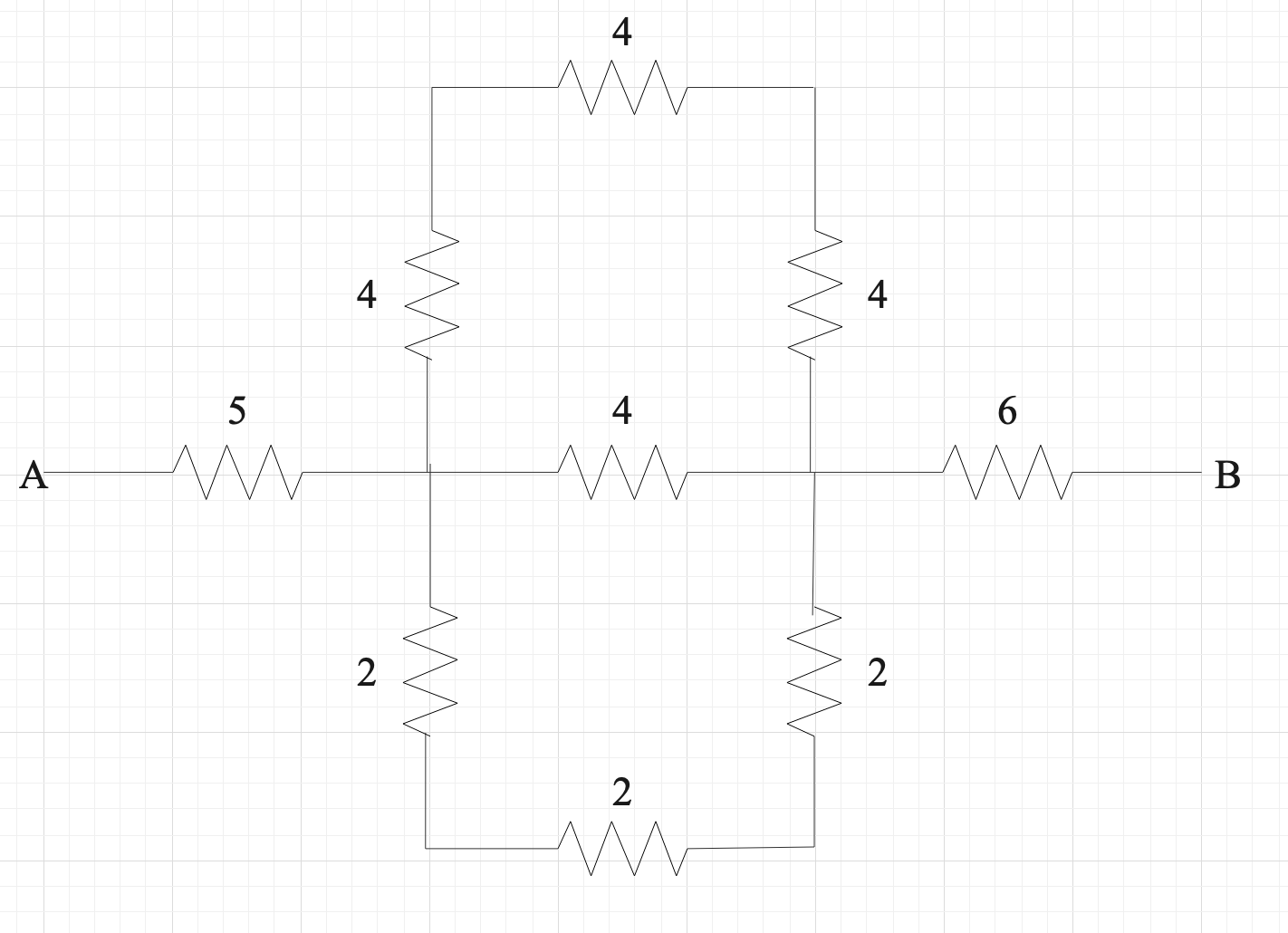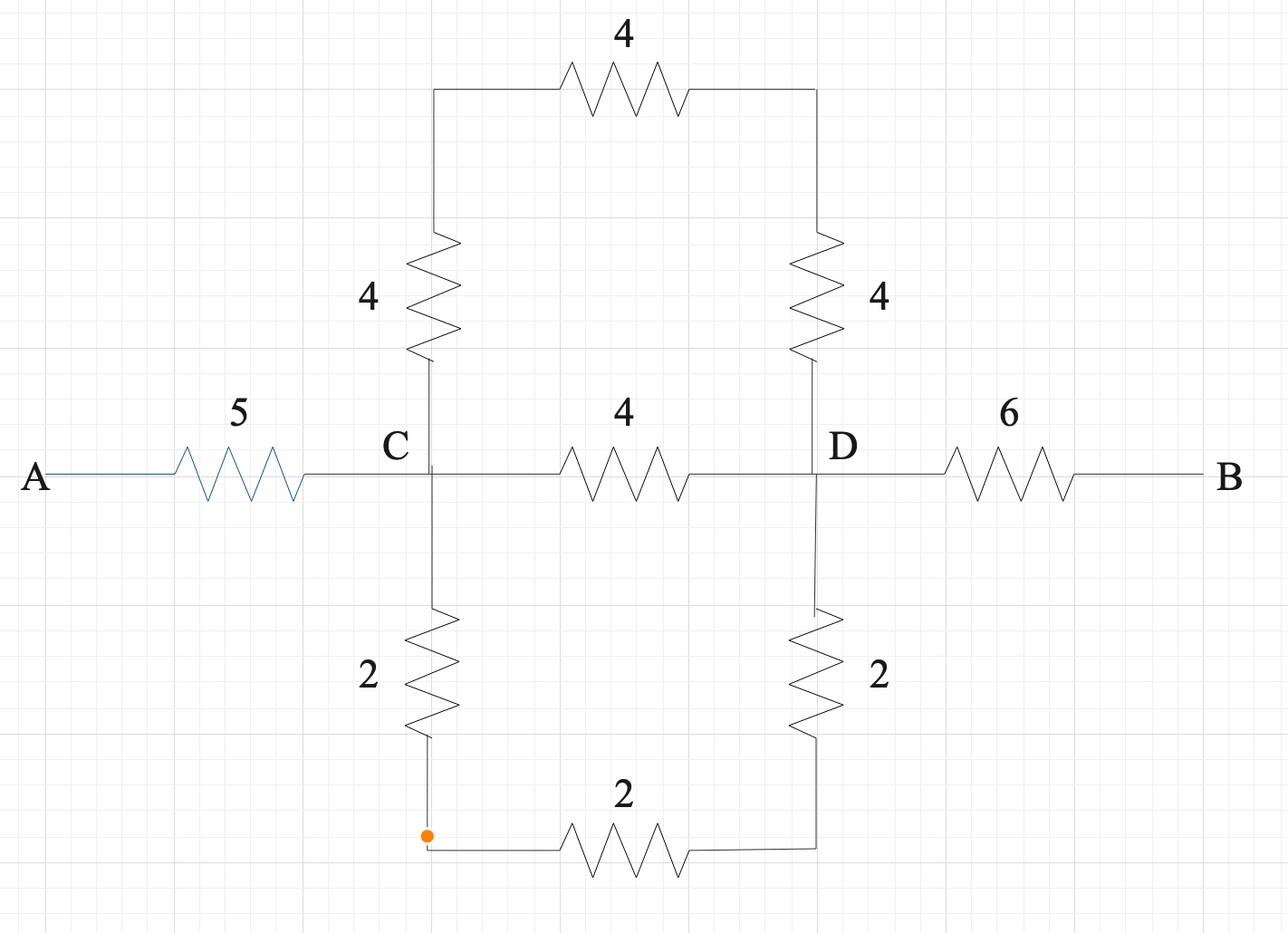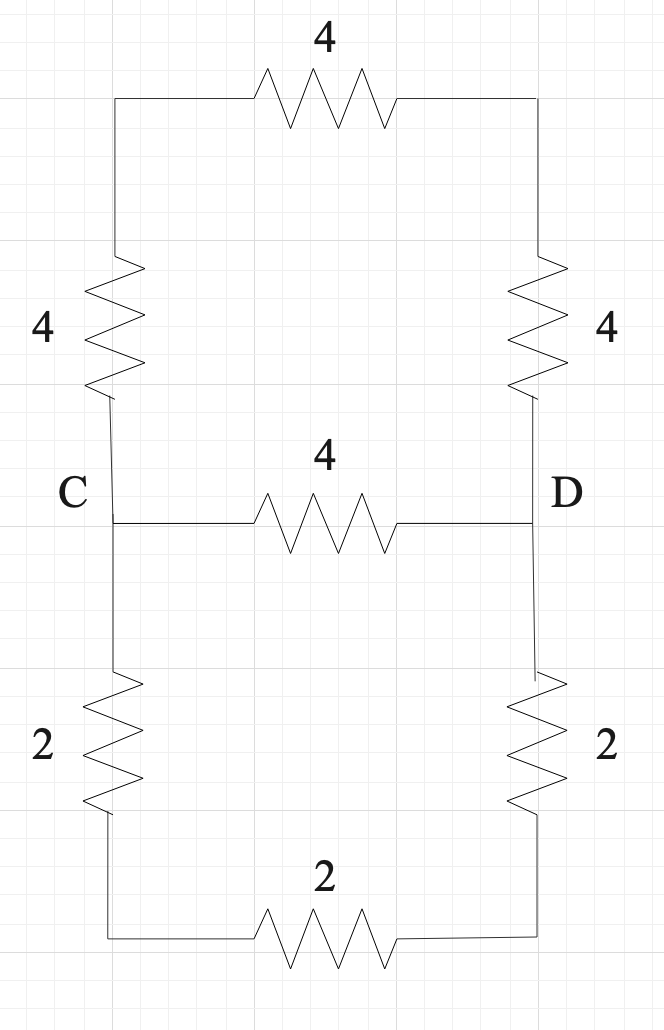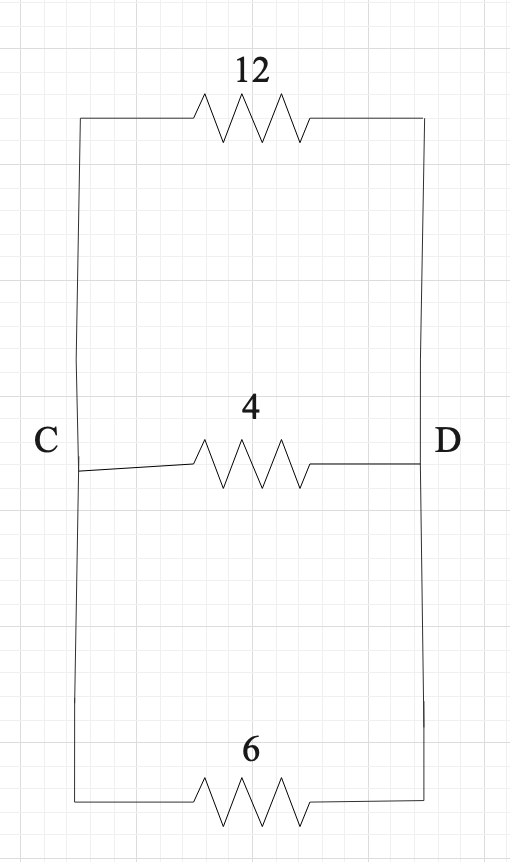
Calculate the equivalent resistance between the points A and B for the following combination of resistors:


Answer
584.1k+ views
Hint: First find the series connections, then solve the parallel connection. Divide the circuit into three segments. Find the equivalent resistance for the middle segment using parallel and series connection formulas. Then calculate the final equivalent resistance using the simple series formula.
Formula Used:
The equivalent resistance of 3 parallel resistors is given by,
$R=\dfrac{{{R}_{1}}{{R}_{2}}{{R}_{3}}}{{{R}_{1}}{{R}_{2}}+{{R}_{2}}{{R}_{3}}+{{R}_{3}}{{R}_{1}}}$.....................(1)
The equivalent resistance of 3 series resistors is given by,
$R={{R}_{1}}+{{R}_{2}}+{{R}_{3}}$.....................(2)
Where,
${{R}_{1}}$ is the resistance of the first resistor,
${{R}_{2}}$ is the resistance of the second resistor,
${{R}_{3}}$ is the resistance of the third resistor.
Complete step by step answer:
First, let us look at the circuit diagram,

For simplicity, we can divide the circuit diagram into three segments,
AC, CD, and DB.
First, let us solve the CD segment.

So, the 4Ω resistances are connected in series, so the equivalent resistance of the top branch is -
(4+4+4) Ω = 12Ω
Now, the equivalent resistance of the bottom branch is -
(2+2+2) Ω = 6Ω
So, the CD segment should look like this:

Now we use equation (1) to get the equivalent resistance of the resistance system.
The equivalent resistance of the CD segment is,
${{R}_{CD}}=\dfrac{{{R}_{1}}{{R}_{2}}{{R}_{3}}}{{{R}_{1}}{{R}_{2}}+{{R}_{2}}{{R}_{3}}+{{R}_{3}}{{R}_{1}}}$
$\Rightarrow {{R}_{CD}}=\dfrac{12\times 4\times 6}{12\times 4+4\times 6+6\times 12}=2$
Hence the overall circuit diagram should like this,

This is a simple series connection. So, the equivalent resistance of the system is,
${{R}_{AB}}=(5+2+6)=13$
The equivalent resistance between points A and B = 13 Ω
Note: We have used a complex formula for the parallel system. You can use the simple formula shown below to calculate the equivalent resistance of the system.
$\dfrac{1}{R}=\dfrac{1}{{{R}_{1}}}+\dfrac{1}{{{R}_{2}}}+\dfrac{1}{{{R}_{3}}}$.....................(3)
Where,
${{R}_{1}}$ is the resistance of the first resistor,
${{R}_{2}}$ is the resistance of the second resistor,
${{R}_{3}}$ is the resistance of the third resistor.
You can use equation (3) to calculate the equivalent resistance of the parallel system. The calculation will be less in some cases.
Formula Used:
The equivalent resistance of 3 parallel resistors is given by,
$R=\dfrac{{{R}_{1}}{{R}_{2}}{{R}_{3}}}{{{R}_{1}}{{R}_{2}}+{{R}_{2}}{{R}_{3}}+{{R}_{3}}{{R}_{1}}}$.....................(1)
The equivalent resistance of 3 series resistors is given by,
$R={{R}_{1}}+{{R}_{2}}+{{R}_{3}}$.....................(2)
Where,
${{R}_{1}}$ is the resistance of the first resistor,
${{R}_{2}}$ is the resistance of the second resistor,
${{R}_{3}}$ is the resistance of the third resistor.
Complete step by step answer:
First, let us look at the circuit diagram,

For simplicity, we can divide the circuit diagram into three segments,
AC, CD, and DB.
First, let us solve the CD segment.

So, the 4Ω resistances are connected in series, so the equivalent resistance of the top branch is -
(4+4+4) Ω = 12Ω
Now, the equivalent resistance of the bottom branch is -
(2+2+2) Ω = 6Ω
So, the CD segment should look like this:

Now we use equation (1) to get the equivalent resistance of the resistance system.
The equivalent resistance of the CD segment is,
${{R}_{CD}}=\dfrac{{{R}_{1}}{{R}_{2}}{{R}_{3}}}{{{R}_{1}}{{R}_{2}}+{{R}_{2}}{{R}_{3}}+{{R}_{3}}{{R}_{1}}}$
$\Rightarrow {{R}_{CD}}=\dfrac{12\times 4\times 6}{12\times 4+4\times 6+6\times 12}=2$
Hence the overall circuit diagram should like this,

This is a simple series connection. So, the equivalent resistance of the system is,
${{R}_{AB}}=(5+2+6)=13$
The equivalent resistance between points A and B = 13 Ω
Note: We have used a complex formula for the parallel system. You can use the simple formula shown below to calculate the equivalent resistance of the system.
$\dfrac{1}{R}=\dfrac{1}{{{R}_{1}}}+\dfrac{1}{{{R}_{2}}}+\dfrac{1}{{{R}_{3}}}$.....................(3)
Where,
${{R}_{1}}$ is the resistance of the first resistor,
${{R}_{2}}$ is the resistance of the second resistor,
${{R}_{3}}$ is the resistance of the third resistor.
You can use equation (3) to calculate the equivalent resistance of the parallel system. The calculation will be less in some cases.
Recently Updated Pages
A man running at a speed 5 ms is viewed in the side class 12 physics CBSE

The number of solutions in x in 02pi for which sqrt class 12 maths CBSE

State and explain Hardy Weinbergs Principle class 12 biology CBSE

Write any two methods of preparation of phenol Give class 12 chemistry CBSE

Which of the following statements is wrong a Amnion class 12 biology CBSE

Differentiate between action potential and resting class 12 biology CBSE

Trending doubts
What are the major means of transport Explain each class 12 social science CBSE

Which are the Top 10 Largest Countries of the World?

Draw a labelled sketch of the human eye class 12 physics CBSE

How much time does it take to bleed after eating p class 12 biology CBSE

Explain sex determination in humans with line diag class 12 biology CBSE

Explain sex determination in humans with the help of class 12 biology CBSE




